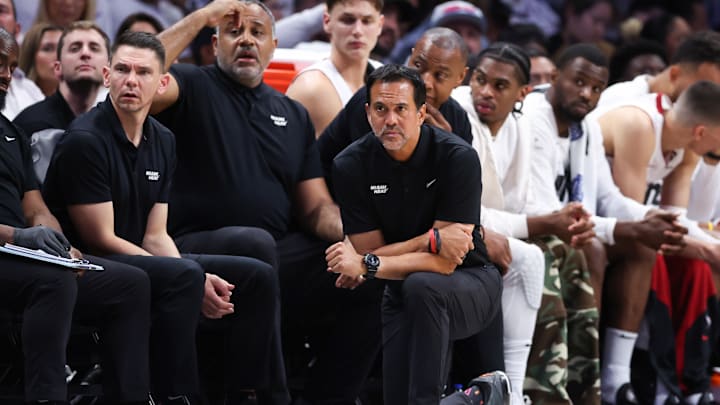During his media session this week, Miami Heat coach Erik Spoelstra said he’s “extremely motivated to get our organization and our basketball team to a higher level. The play-in is obviously not where we want to be.”
There are plenty of things for the Heat to address this offseason, from an offense that doesn’t score enough points to other, more troubling statistics once you pop open the hood. A look at the statistics the Heat need to improve on from last season.
1. Offensive rating: 21st
The Heat finished in the bottom 10 in offensive rating for the third straight season. Of the six teams that have already made it to the second round of the playoffs, all finished the regular season ranked in the top nine in offensive efficiency.
The Heat need to be better on offense, but a closer look at some key offensive indicators suggests they have a way to go. Miami ranked 18th in True Shooting percentage, 24th in free-throw attempt rate, 28th in second chance points, 21st in points in the paint, 22nd in points off turnovers, 16th in 3-point attempts, and 19th in points scored in isolation.
In other words, they didn’t do anything at a high level on that end of the court.
Every offensive possession for the Heat is a slog. Without an elite shot creator, Miami has trouble forcing advantages and often has to work deep into the shot clock to get a decent look.
This is primarily a personnel issue, but Spoelstra’s scheme needs work, too. Going into the season, Spoelstra scrapped his low-post-based offense in favor of a five-out scheme meant to help guys like Tyler Herro, Terry Rozier and Jimmy Butler play in space. That didn’t work out, as Rozier struggled, Nikola Jovic fell out of the starting lineup, and Butler forced a trade.
Now it’s back to the drawing board, but adding a star might be the only way for the Heat to crack the league’s top 10 in offense for the first time since 2020.
2. Clutch games lost: 28
The Heat were 14-28 in games within five points in the final five minutes this season. Win a few more of those, and maybe the Heat aren’t drawing the top seed in the first round.
Herro said one of his priorities this summer is figuring out how to impact those clutch moments more.
“That’s what I will be working on this summer, a lot of film, a lot of studying what went wrong this year,” Herro said, “so that if we’re in those situations next year, we can turn those into wins instead of losses.”
Some of this is due to variance. Miami shot 25.6% on 3-pointers in clutch situations, versus 36.7% on 3s overall. Meanwhile, opponents’ 3-point shooting percentage remained flat – about 36% – between overall game time and clutch situations.
But the Heat also lacked an identity in crunch time after the Butler trade. They had a hard time creating open looks, and opponents feasted on misses. Defenses tend to dial it up in the biggest moments, and Miami’s offense isn’t good enough to score consistently against a locked-in opponent.
3. Pace: 27th
The Jimmy Butler era is over, and so is the need to slow things down to his tempo. Butler is at his best when prodding a defense from the block and finding his shot. Without him, the Heat would be better off pushing the pace to create advantages.
The Heat are young! Adebayo is 27. Herro is 25. There’s an assortment of under-24 contributors. Let these Broncos buck!
If this roster looks similar next season – even with a star added to the mix – running should be a priority when Spoelstra redraws the offense. A higher pace means more 3-pointers for Herro, more transition opportunities (and dunks) for Adebayo and Davion Mitchell (if re-signed) fast-balling his way down the court.
The Heat are a young team now. They should play like it.
4. Offensive rebounding rate: 27th
Part of the reason for playing two bigs is to be able to rebound your misses. The Heat didn’t do that, ranking near the bottom of the league in offensive rebounding rate last season.
And before you point out that Kel’el Ware didn’t start until January, well, the Heat ranked the same – 27th – after Ware joined the starting lineup.
Bam Adebayo has never been an elite offensive rebounder for his position, and Ware was a 19-year-old who spent most of his rookie season getting pushed around like a child in a sandbox.
“Getting stronger,” was Ware’s response when asked what he was going to work on this summer.
Neither Adebayo nor Ware will get confused for Steven Adams on the offensive glass, but they need to come together to be a bigger factor on the boards for this two-big lineup to make any sense.
5. Opponent turnover percentage: 14.1%
The Heat ranked 17th in opponent turnover rate. That’s not a terrible stat in a vacuum, but it’s troubling when the coach preached about the importance of turning their opponent over before the season.
Miami’s mid-season shift from a smaller, blitzing team with Butler (supposedly) wreaking havoc from the wing to a team without Butler and based on a two-big lineup has a lot to do with the drop-off in forcing turnovers.
However, Spoelstra has prioritized forcing turnovers since the Big 3 era. It’s part of his coaching manifesto. He wants the Heat to be aggressive, and there’s a version of this team that can still crank it up on that end.
Mitchell is a steals machine and Herro has an underrated ability to jump passing lanes. With Adebayo as the defensive anchor, the Heat should always be one step ahead. Add Ware’s potential shot-blocking to the mix, and Miami has the outlines of a team that can turn defense into offense.
